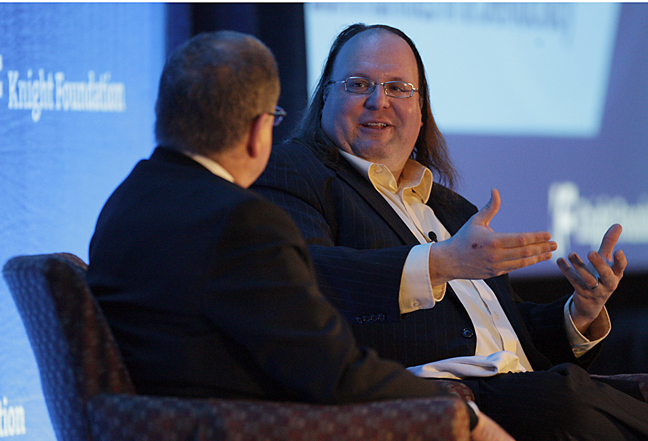
Zuckerman: How to use media to amplify community voices
Ethan Zuckerman believes the Internet is the most powerful tool humans have to understand one another’s differences. But, he says, we’ve yet to tap its potential. “The way we use the Internet keeps us from making those connections,” said the director of the MIT Center for Civic Media and founder of Global Voices.
Zuckerman told the hundreds gathered for Knight’s Media Learning Seminar that the sociological phenomenon of homophily — the tendency to gravitate toward people with similar traits — also governs our Web habits and online conversations. “We find the same ways to sort ourselves in whom we associate with online,” Zuckerman said.
In a speech Tuesday, Zuckerman told foundation and community leaders that the task for content producers today is to act as guides to the Internet, helping show audiences not only what they want to see, but what they need to see. “As tourists in a city, if we want to see various parts of the city, we find a guide. How do we create guides for the Internet?” Zuckerman asked.
His work with the Center for Civic Media centers on how to map, contextualize and amplify global voices with tools that, he says, can be applied to any community. Zuckerman’s four-step approach:
1.) Assess your audience.
Figure out who you’re hearing from and who you’re not hearing from before embarking on creating an information platform. What are the stories you’re hearing and stories you are not hearing? Who makes it into the newspapers? Who gets quoted, who doesn’t get quoted?
2.) Learn where people are communicating and what tools they are using.
Old-fashioned pen and paper might be the most important way people are communicating in a given community, as MIT has found. Use whatever tools work for the group you are trying to engage. Projects like Voces Moviles — which engaged immigrant workers by using text messages — help people within a community understand information on the platforms they already use. Find out the tools that can best connect people to their specific communities.
3.) To effectively compile what people are saying, use curation, translation and context.
Strong online information guides require three main elements, Zuckerman said. Curation, or combing through information in your community to pull out the most interesting or relevant pieces; translation, or making the information understandable, and context, adding why the information matters. “If your job is to tell people what is going on in a given community, take that conversation and make it understandable,” said Zuckerman. “Our responsibility to people who care about our communities is listening to the broader conversations and putting them together in a way that people can listen to them,” said Zuckerman.
4.) Love makes it go.
The people who are successful at engaging their communities using this method do it because they love three things: The communities they’re representing, the online medium, and the ability to say, “I can tell you what’s going on in my community and I can get heard all over the world.” Look for others who are “in love” in the same way. It’s a path toward allowing communities to become the participators, creators and curators of their own conversations.
Elise Hu is covering the event as a freelance writer for KnightBlog. She is the digital editor of StateImpact at NPR.
Recent Content
-
Communitiesarticle ·
-
Communitiesarticle ·
-
Communitiesarticle ·


